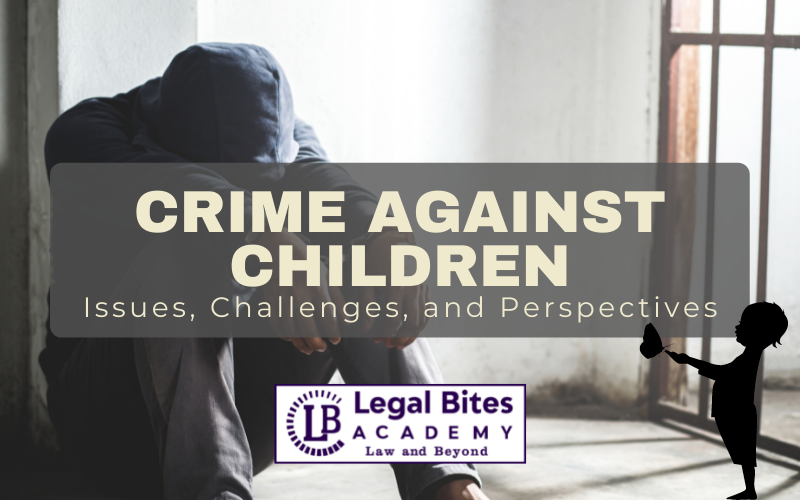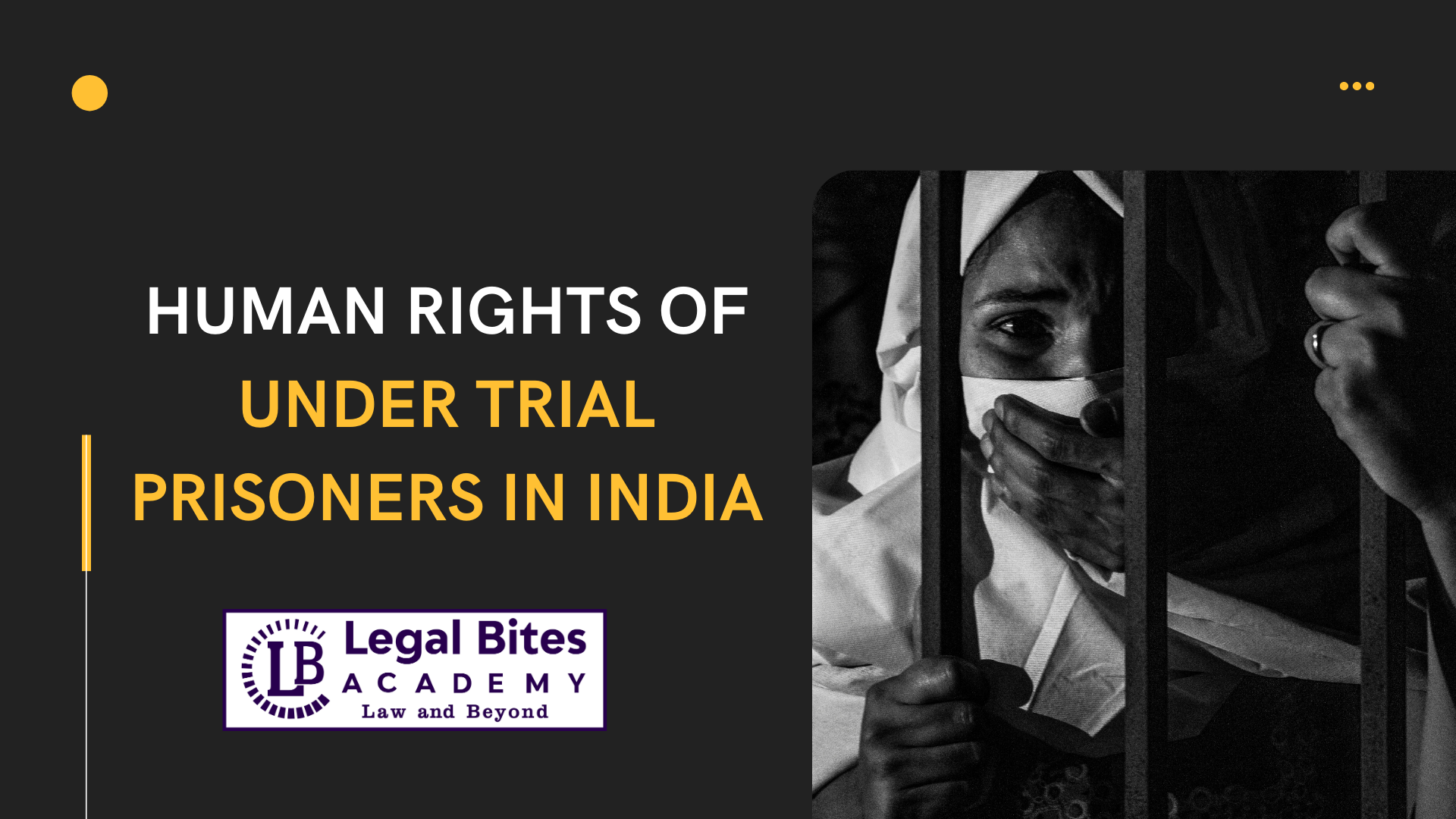Crime against Children: Issues, Challenges, and Perspectives
Crime against children in any form is dirt on society that needs to be curbed at any cost. The present article provides a detailed discussion on the persisting problem of crime against children. The article deals with the context, issues behind, and perspectives on the crime against children, with a special focus on the current Indian scenario. In… Read More »
;
Crime against children in any form is dirt on society that needs to be curbed at any cost. The present article provides a detailed discussion on the persisting problem of crime against children. The article deals with the context, issues behind, and perspectives on the crime against children, with a special focus on the current Indian scenario. In India, laws prohibiting crime against children primarily originate from the Criminal Law and POSCO, so the author attempts to discuss the...
Crime against children in any form is dirt on society that needs to be curbed at any cost. The present article provides a detailed discussion on the persisting problem of crime against children. The article deals with the context, issues behind, and perspectives on the crime against children, with a special focus on the current Indian scenario.
In India, laws prohibiting crime against children primarily originate from the Criminal Law and POSCO, so the author attempts to discuss the salient features of the statutes to be effective against any kind of crime against children in India.
I. Introduction
Crime against children can be in any form of abuse including physical, emotional, neglect, and exploitation of the child as through sex trafficking and child pornography. In India, there are several protective and preventive special and local laws along with the Indian Penal Code as main legislation, which specifically describes the criminal offences wherein children or minors are victims.
The concerned statutes provide definitions of crime against children but it is seen that the age of the child varies through these acts. However, as per the amended Juvenile (Care and Protection of Children) Act, 2000, the legal definition for the age of the child has been defined to be below 18 years of age. Therefore, for the purpose of analysis and discussion, please note that a criminal offence committed on a minor under the age of 18 years is considered a crime against children.
Currently, the Indian Criminal Law (Amendment) Bill, 2018 governs the cases of child rape in the country and it provides for awarding the death penalty to the convicts. The death penalty will be awarded as maximum punishment to the convicts of rape of a child under the age of 12 years.
Protection of rights of children under Indian Law
Juvenile Justice (Care and Protection of Children) Act, 2018
JJ Act, 2018 is the fundamental enactment in the country which deals with children who are in need of care and protection. The act caters to the needs of the children through providing proper care, protection, treatment, development, and social reintegration, by adopting its child-friendly approach and by addressing legal matters in the best interest of children.
Crimes punishable under IPC
Crimes against children which are specifically mentioned to be punishable under the law are provided under various sections of the Indian Penal Code. They are as follow:
- Crime against a foetus; known as Foeticides: Section 315 & 316 IPC
- Crime against a new-born child under the age of 0-1 year; known as Infanticides: Section 315 IPC
- Abetment to Suicide by children: Section 305 IPC
- Crime against children by their parents or others to expose or leave them with a clear intention of abandonment: Section 317 IPC
- Procuration of minor girls for inducement to force or engage in illicit intercourse: Section 366-A IPC
- Selling of girls for prostitution: Section 372 IPC
- Buying of girls for prostitution: Section 373 IPC
- Rape: Section 376 IPC
- Kidnapping and Abduction of child: Sections 360, 361, 363, 366, 367, 369 of IPC
Protection of Children from Sexual Offences Act (POCSO Act), 2012
The POSCO Act was enacted with an aim to protect children against criminal offences such as sexual abuse, sexual harassment, and pornography. The act was passed to create a child-friendly justice system for the trial and punishment of offenders.
The Constitution of India, 1950 on rights of children
There are certain constitutional provisions that deal with the rights of children. They are:
- Article 21: provides for the right to life and personal liberty of an individual.
- Article 21 (a): State shall provide free and compulsory education to all children of the age of 6 to 14 years.
- Article 24: No child below the age of 14 years shall be employed to work in any factory or mine or engaged in any other hazardous employment.
- Article 39(f) provides that children are given proper facilities and opportunities to grow in a healthy manner and in the condition of freedom and dignity. This entails protecting children against any exploitation, moral, or material abandonment.[1]
II. Issues and Challenges with the crime against children in India
The child rights NGO, CRY in its report has mentioned that sexual offences committed against a child in India occur every 15 minutes and the country has seen a tremendous increase with more than 500% rise over the past 10 years in crime against children.
According to the report of NCRB Data, the crime against children has increased by 4.5% in 2019 with as many as 1, 48,185 crimes reported in the country while the POSCO cases rise to 19%.[2] The continuous rising of cases is indeed a disturbing scenario and a grave concern and the country demands strict enforcement of laws.
So, what is the main issue leading to this rise in the number of offences against minors? Well, as per NCRB statistics, most of the child offenders are known to the victim, and almost half of them are close relative and neighbours. Besides, the main problem lies in the lower conviction rate of the offenders.
The 2016 data of NCRB suggests a very low conviction rate for the offenders of these crimes which accounts to only 3% of the total number of cases reported. The chief cause behind this much low conviction rate is the lack of proper infrastructure, manpower and of course the enforcement and implementation of stringent laws.
Moreover, despite the fact the POSCO was already enacted in 2012, the country has seen no reduction in the number of crimes committed against children. The main reason behind so is that the law to deal with such cases has never acted as a deterrent to the offenders. Besides, the usual delay in disposal of cases by the court stretches to decades and many of them are left lending for several years. This leads to delay in justice only because of the shortage of manpower i.e. judges, facilities to record evidence and start the investigation on time hardly happens.
The victims are often not given proper recourse to put their grievances and instead they have to face humiliation by the police personnel and others where they are subjected to degrading medical tests in the garb of medical examination. Because of the scarcity of infrastructure and enforcement of laws, many cases don’t reach the court which has a big role to play in the ever-increasing rate of crime against children.
Debate on Capital Punishment
While there is an increase in demand for giving capital punishment to offenders of minors, capital punishment is still a debatable subject in India among the legal fraternity, criminologists, and sociologists. In the case of Bachan Singh v State of Punjab[3], Justice P Bhagwati while delivering his dissenting opinion in the case held capital punishment to be unconstitutional. The Law Commission of India has also provided in its report that there is no evidence suggesting that the death penalty to an offender has a deterrent effect over life imprisonment.
The Justice JS Verma Committee which was formed in 2012 after the Delhi Gang rape and murder case has concluded in its report[4], that the death penalty would be a regressive step in the field of sentencing and reformation of offenders. With the already underreporting of cases of child abuse, along with the prevalent social stigma, poor response from the criminal justice system is only going to make the scenario worse. Therefore, there is a need to increase the punishment for crime against children, including the death penalty, and then only the country can observe a decrease in the rate of reporting of such crimes.
III. Conclusion
Crime against children is widespread and pervasive which makes it a harsh reality for millions of children in India. With the promulgation of the Criminal Law (Amendment) Ordinance on April 21, 2018, the country has of late yet adopted major legal reforms to curb abuse of children; however, there are serious lacunae in their execution. What acts as a deterrent for the perpetrator of the crime is the certainty and uniformity of punishment rather than the nature of the punishment given.
The current criminal justice system needs to realize victim’s access to justice and deterrence of crime for better implementation of existing laws and systematic changes. There is a need to increase the conviction rates of offenders through stringent police and judicial system.
Additionally, the lack of infrastructure to deal with such cases also needs to be dealt with on an urgent basis by strengthening the judicial system to handle and support victims. This will ensure better investigations which in turn will translate into a better conviction rate of the offenders. The state must also allocate a greater pool of resources towards setting up fast track courts and expansive victim compensation schemes and most importantly making the overhaul of child protection services better.
[1] INDIAN CONST. ART. 39(f).
[2] Bharti Jain, Centre claims better enforcement as Pocso cases rise 19% in 2019, Available Here
[3] Bachan Singh v. State of Punjab, 1983 SCR (1) 145.
[4] Justice JS Verma Committee Report, Available Here





